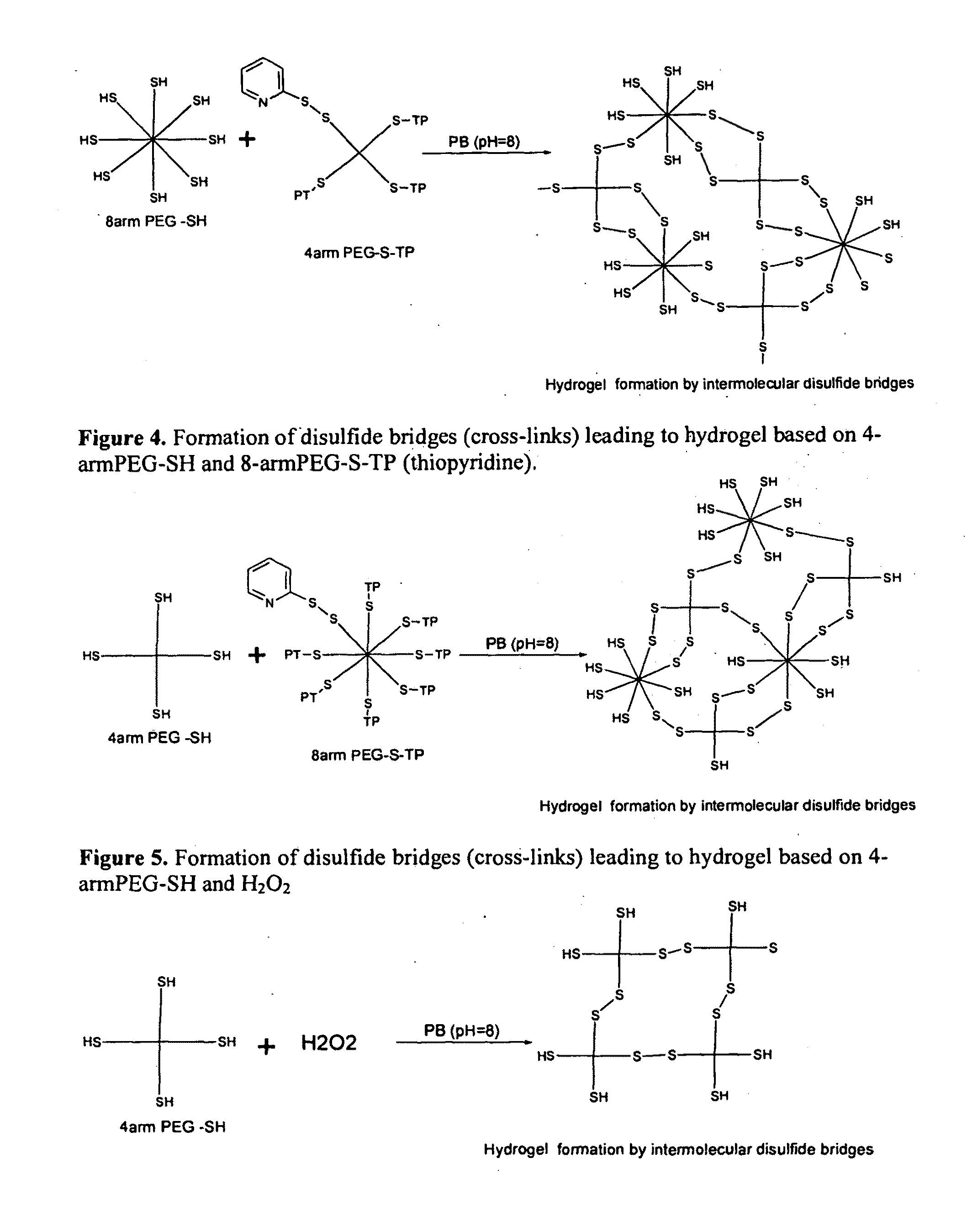Dressing compositions and methods
a composition and dressing technology, applied in the field of hydrogel-based wound dressings, can solve the problems of difficult removal of difficult peeling off, and difficulty in removing adhesive gauze or patch products, etc., and achieves the effects of easy and painless removal, high conformability, and easy solubl
- Summary
- Abstract
- Description
- Claims
- Application Information
AI Technical Summary
Benefits of technology
Problems solved by technology
Method used
Image
Examples
example 1
Hydrogel Formation
[0060]The hydrogel network or matrix composition is obtained by formation of disulfide bridges or formation of thioether bonds in the PEG (polyethylene glycol) having a thiol group (reduced sulfhydryls groups ‘SH’) at each terminus. The cross-linking of PEG with thiol terminal groups is achieved by reacting the same with H2O2, maleimide cross-linkers (like bis-maleimido di / triethylene glycol derivatives eg. BMPEO2 (bis-maleimido diethylene glycol) and BMPEO3 (bis-maleimido triethylene glycol) BMOE (Bis-Maleimidoethane), BMH (bismaleimidohexane)) or PEG having a thiopyridine (TP) groups at the terminus or PEG having vinyl sulfone terminal groups or any other compound capable of forming the disulfide or thioether bonds with ‘SH’ terminated PEGs. The PEG polymers having thiol terminus groups include 2-,3-,4-, 8-arm or multiple arm thiol PEGs in the molecular weight range of 2,000 to 100,000 Da. Alternately the hydrogels can be obtained by cross-linking the PEG having ...
example 2
Adhesion
[0073]To enhance the adhesion of the gel to eye and the skin the cell adhesive component is incorporated in the gel. Accordingly, one of the embodiments of the present invention discloses the use of the peptide sequence, Arg-Gly-Asp (RGD), which is naturally present in many proteins involved in adhesion of cells to other cells and to basement membrane. As a result of better contact, this provides better transfer of a drug from the gel to the site of application. Furthermore, the presence of RGD sequences can be recognized by cellular receptors, thereby serving as attachment sites on the corneal epithelial cells or keratinocytes cells on the skin. The RGD is known to accelerate skin and wound repair.
[0074]RGD peptide comprising the ‘Arg-Gly-Asp’ sequence, such as the linear peptide Arg-Gly-Asp-Cys, Gly-Arg-Gly-Asp-Ser, Gly-Arg-Gly-Asp-Ser-Pro, or as the cyclic peptide Cyclo-Arg-Gly-Asp-Try-Lys, were used to enhance the adhesion of the gel on the cells and were synthesized as ...
example 3
Formulations with Additives
[0080]A spray-on hydrogel was obtained by dissolving the thiol terminated PEG (4-arm-PEG-SH and 8-arm PEG-SH) and the thiopyridine terminated PEG (4-arm-PEG-S-TP and 8-arm PEG-S-TP) (Formulation in accordance with Example 1c), and an additive comprising a solution of polyvinyl pyrrolidone (PVP) in phosphate buffer pH 8. The concentration of PVP was varied from 1.5-2% w / v as shown in Table 9.
TABLE 9Hydrogel Compositions with additive PVPRatio Conc.Conc. OfS.ofOf PVPpolymersNoCompositionspolymers(% w / v)(% w / v)14-arm-PEG-S-TP +1:1—54-arm-PEG-SH8-arm-PEG-S-TP +1:1—58-arm-PEG-SH8-arm-PEG-S-TP +1:1—54-arm PEG-SH24-arm-PEG-S-TP +1:11.554-arm-PEG-SH8-arm-PEG-S-TP +1:18-arm-PEG-SH8-arm-PEG-S-TP +1:14-arm PEG-SH34-arm-PEG-S-TP +1:1254-arm-PEG-SH8-arm-PEG-S-TP +1:18-arm-PEG-SH8-arm-PEG-S-TP +1:14-arm PEG-SH
[0081]Two spray-on hydrogels were obtained by dissolving the thiol terminated PEG (8-arm PEG-SH) and the thiopyridine terminated PEG (8-arm PEG-S-TP) (in accordanc...
PUM
| Property | Measurement | Unit |
|---|---|---|
| molecular weight | aaaaa | aaaaa |
| molecular weight | aaaaa | aaaaa |
| pH | aaaaa | aaaaa |
Abstract
Description
Claims
Application Information
 Login to View More
Login to View More - R&D
- Intellectual Property
- Life Sciences
- Materials
- Tech Scout
- Unparalleled Data Quality
- Higher Quality Content
- 60% Fewer Hallucinations
Browse by: Latest US Patents, China's latest patents, Technical Efficacy Thesaurus, Application Domain, Technology Topic, Popular Technical Reports.
© 2025 PatSnap. All rights reserved.Legal|Privacy policy|Modern Slavery Act Transparency Statement|Sitemap|About US| Contact US: help@patsnap.com



